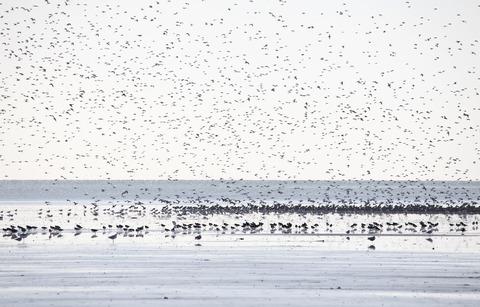当前位置:
X-MOL 学术
›
Anim. Conserv.
›
论文详情
Our official English website, www.x-mol.net, welcomes your
feedback! (Note: you will need to create a separate account there.)
Cumulative energetic costs of military aircraft, recreational and natural disturbance in roosting shorebirds
Animal Conservation ( IF 2.8 ) Pub Date : 2019-11-08 , DOI: 10.1111/acv.12546 H. Kolk 1, 2 , K. L. Krijgsveld 3 , H. Linssen 1 , R. Diertens 1 , D. Dolman 1 , M. Jans 1 , M. Frauendorf 1, 2 , B. J. Ens 2, 4 , M. Pol 1, 2
Animal Conservation ( IF 2.8 ) Pub Date : 2019-11-08 , DOI: 10.1111/acv.12546 H. Kolk 1, 2 , K. L. Krijgsveld 3 , H. Linssen 1 , R. Diertens 1 , D. Dolman 1 , M. Jans 1 , M. Frauendorf 1, 2 , B. J. Ens 2, 4 , M. Pol 1, 2
Affiliation

|
Knowing the consequences of disturbance for multiple species and all disturbance sources is crucial to mitigate disturbance impacts in densely populated areas. However, studies that observe the complete disturbance landscape to estimate cumulative costs of disturbance are scarce. Therefore, we quantified responses, frequencies and energetic costs of disturbance of four shorebird species on five high tide roosts in the Wadden Sea. Roosts were located either in a military air force training area or were predominantly affected by recreational disturbance. In the military training area, infrequent transport airplanes and bombing jets elicited the strongest responses, whereas regular, predictable activities of jet fighters and small civil airplanes elicited far smaller responses. Disturbance occurred more frequently at roosts near recreational than near military activities, as recreation was prohibited in the military area during operation days. On average, birds took flight due to military, recreational or natural disturbance (e.g. raptors) 0.20–1.27 times per hour. High tide disturbance increased daily energy expenditure by 0.1%–1.4%, of which 51% was due to anthropogenic disturbance in contrast to natural disturbance. Costs were low for curlews Numenius arquata, oystercatchers Haematopus ostralegus and gulls Larus spp, but higher – and potentially critical – for bar‐tailed godwits Limosa lapponica as they were most susceptible to aircraft and raptors. Given that bar‐tailed godwits have previously been found to be least susceptible to walker disturbances, our results suggest that interspecific differences in susceptibility depend on disturbance source type. In our study area, aircraft disturbance impacts can be reduced by avoiding jet fighter activities during periods when high water levels force birds closer to military targets and by limiting bombing and transport airplane exercises.
中文翻译:

军用飞机的累积能量消耗、栖息的滨鸟的娱乐和自然干扰
了解干扰对多种物种和所有干扰源的影响对于减轻人口稠密地区的干扰影响至关重要。然而,观察完整的干扰景观以估计干扰的累积成本的研究很少。因此,我们量化了瓦登海五个高潮栖息地的四种滨鸟物种干扰的响应、频率和能量成本。栖息地要么位于军事空军训练区,要么主要受到娱乐干扰的影响。在军事训练领域,不频繁的运输机和轰炸机引起的反应最强烈,而喷气式战斗机和小型民用飞机的定期、可预测的活动引起的反应要小得多。与靠近军事活动的场所相比,娱乐场所附近的栖息地更容易受到干扰,因为在作战期间军事地区禁止娱乐活动。平均而言,鸟类因军事、娱乐或自然干扰(例如猛禽)每小时飞行 0.20-1.27 次。高潮扰动使每日能量消耗增加了 0.1%–1.4%,其中 51% 是由于与自然扰动相反的人为扰动。卷尾鹬 Numenius arquata、牡蛎捕食者 Haematopus ostralegus 和海鸥 Larus spp 的成本较低,但对斑尾鹬类 Limosa lapponica 的成本较高,而且可能很严重,因为它们最容易受到飞机和猛禽的影响。鉴于之前已经发现斑尾鹬最不容易受到步行者的干扰,我们的结果表明,敏感性的种间差异取决于干扰源类型。在我们的研究区域,可以通过在高水位迫使鸟类靠近军事目标期间避免喷气式战斗机活动以及通过限制轰炸和运输机演习来减少飞机干扰影响。
更新日期:2019-11-08
中文翻译:

军用飞机的累积能量消耗、栖息的滨鸟的娱乐和自然干扰
了解干扰对多种物种和所有干扰源的影响对于减轻人口稠密地区的干扰影响至关重要。然而,观察完整的干扰景观以估计干扰的累积成本的研究很少。因此,我们量化了瓦登海五个高潮栖息地的四种滨鸟物种干扰的响应、频率和能量成本。栖息地要么位于军事空军训练区,要么主要受到娱乐干扰的影响。在军事训练领域,不频繁的运输机和轰炸机引起的反应最强烈,而喷气式战斗机和小型民用飞机的定期、可预测的活动引起的反应要小得多。与靠近军事活动的场所相比,娱乐场所附近的栖息地更容易受到干扰,因为在作战期间军事地区禁止娱乐活动。平均而言,鸟类因军事、娱乐或自然干扰(例如猛禽)每小时飞行 0.20-1.27 次。高潮扰动使每日能量消耗增加了 0.1%–1.4%,其中 51% 是由于与自然扰动相反的人为扰动。卷尾鹬 Numenius arquata、牡蛎捕食者 Haematopus ostralegus 和海鸥 Larus spp 的成本较低,但对斑尾鹬类 Limosa lapponica 的成本较高,而且可能很严重,因为它们最容易受到飞机和猛禽的影响。鉴于之前已经发现斑尾鹬最不容易受到步行者的干扰,我们的结果表明,敏感性的种间差异取决于干扰源类型。在我们的研究区域,可以通过在高水位迫使鸟类靠近军事目标期间避免喷气式战斗机活动以及通过限制轰炸和运输机演习来减少飞机干扰影响。











































 京公网安备 11010802027423号
京公网安备 11010802027423号